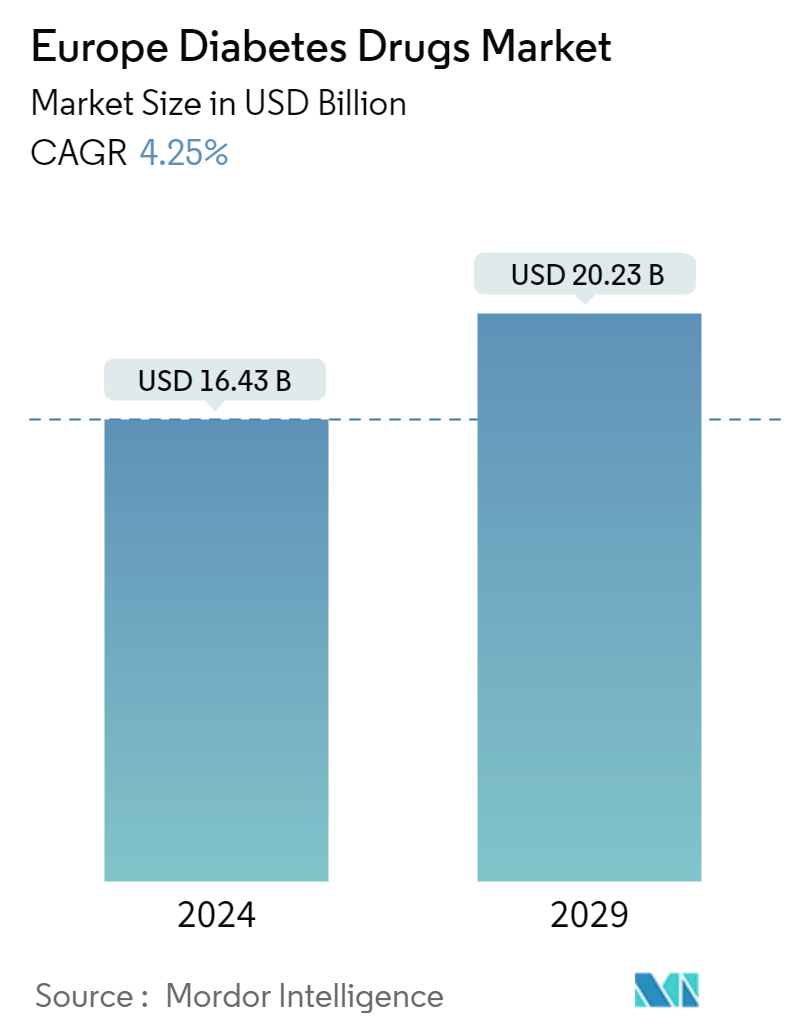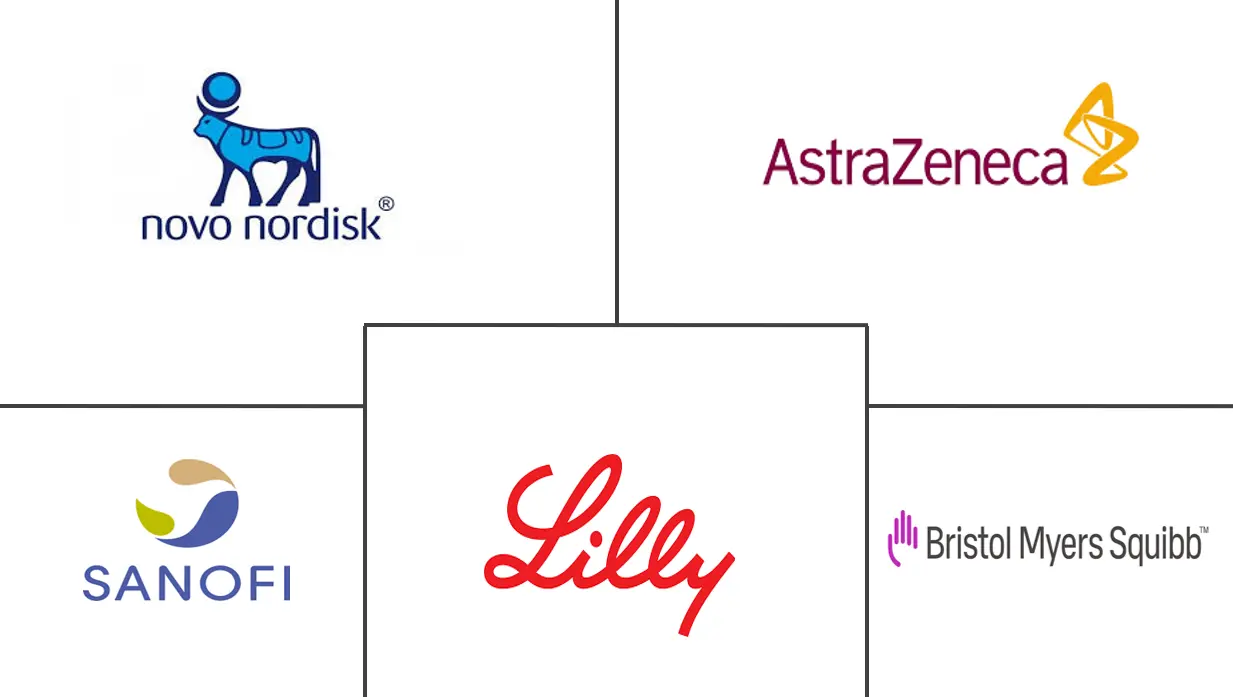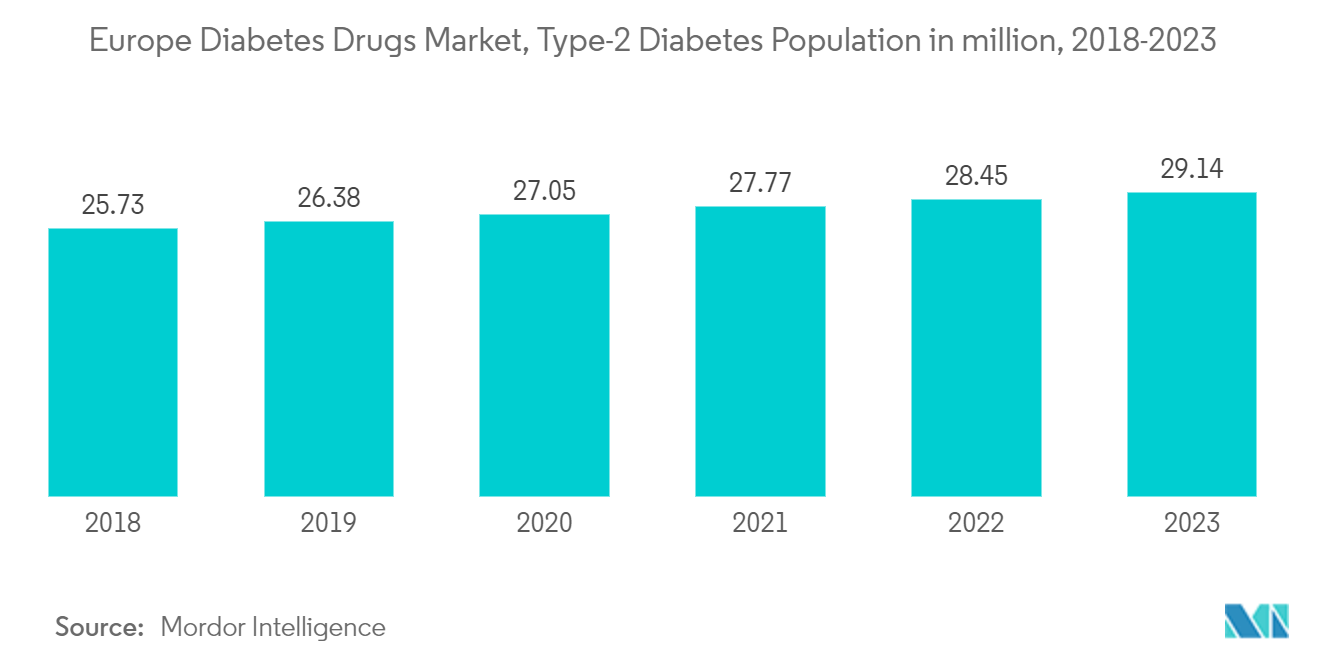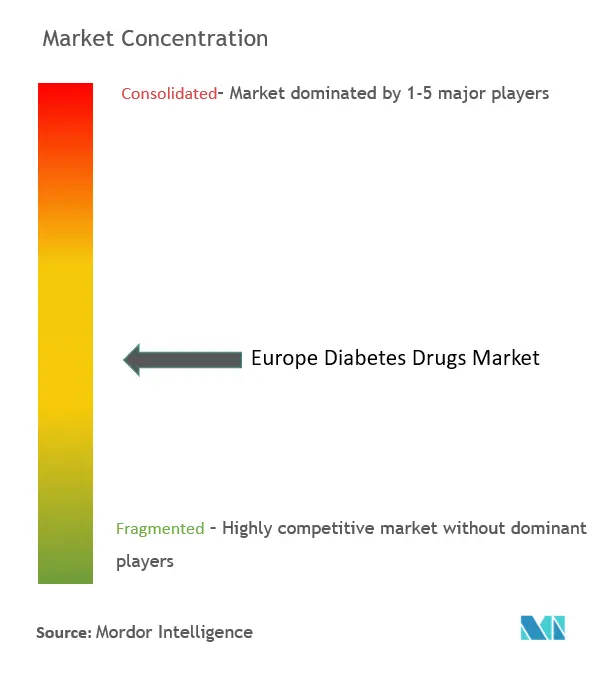Europe Diabetes Drugs Market Size

| Study Period | 2018 - 2029 |
| Base Year For Estimation | 2023 |
| Forecast Data Period | 2024 - 2029 |
| Market Size (2024) | USD 16.43 Billion |
| Market Size (2029) | USD 20.23 Billion |
| CAGR (2024 - 2029) | 4.25 % |
Major Players
*Disclaimer: Major Players sorted in no particular order |
Europe Diabetes Drugs Market Analysis
The Europe Diabetes Drugs Market size is estimated at USD 16.43 billion in 2024, and is expected to reach USD 20.23 billion by 2029, growing at a CAGR of 4.25% during the forecast period (2024-2029).
The rising number of diabetes cases in Europe is fueling growth in the European market for diabetes drugs due to several factors. Firstly, the increasing prevalence of diabetes in the region has created a larger patient pool in need of medication, leading to a higher demand for diabetes drugs. This demand is expected to continue growing as the population ages and the risk factors for diabetes, such as obesity and sedentary lifestyles, persist.
Additionally, advancements in medical technology and research have resulted in the development of more effective and innovative diabetes drugs. These new drugs offer improved glycemic control, reduced side effects, and enhanced convenience for patients, thereby driving the market growth. Pharmaceutical companies are investing heavily in research and development to bring these new drugs to the market, further stimulating the growth of the European diabetes drug market.
Moreover, governments and healthcare organizations in Europe are increasingly focusing on diabetes prevention and management programs. These initiatives aim to raise awareness about diabetes, promote healthy lifestyles, and ensure access to affordable and effective diabetes drugs. As a result, there is a growing emphasis on early diagnosis and treatment, leading to an increased demand for diabetes drugs.
Furthermore, the European market for diabetes drugs is witnessing a surge in mergers, acquisitions, and collaborations among pharmaceutical companies. These strategic partnerships allow companies to combine their resources, expertise, and product portfolios to better address the growing demand for diabetes drugs. Such collaborations also enable companies to expand their geographical reach and tap into new markets, further driving the market growth.
In conclusion, the rising number of diabetes cases in Europe is fueling growth in the European market for diabetes drugs. Factors such as the increasing prevalence of diabetes, advancements in medical technology, government initiatives, and strategic collaborations among pharmaceutical companies are all contributing to the expansion of this market. As the demand for diabetes drugs continues to rise, the market is expected to witness further growth in the coming year.
Europe Diabetes Drugs Market Trends
The Oral anti-diabetic drugs segment held the highest market share in the Europe Diabetes Drugs Market in the current year
According to the IDF, the overall diabetes expenditure in Europe among the population aged 20-79 years was USD 156 billion and is expected to increase to USD 174 billion by 2040. These figures indicate that approximately 9% of the total healthcare expenditure is spent on diabetes in Europe. The rapidly increasing incidence and prevalence of diabetic patients and healthcare expenditure are indications of the increasing usage of diabetic drugs.
Oral Anti-Diabetic Drugs are available internationally and are recommended for use when escalation of treatment for type 2 diabetes is required along with lifestyle management. Oral agents are typically the first medications used in treating type 2 diabetes due to their wide range of efficacy, safety, and mechanisms of action.
Anti-diabetic drugs help diabetes patients control their condition and lower the risk of diabetes complications. People with diabetes may need to take anti-diabetic drugs for their whole lives to control their blood glucose levels and avoid hypoglycemia and hyperglycemia. Oral anti-diabetic agents present the advantages of easier management and lower cost. So they became an attractive alternative to insulin with better acceptance, which enhances adherence to the treatment.
The government and the companies are working towards better diabetes management. For instance, the National Service Framework (NSF) program is improving services by setting national standards to drive up service quality and tackle variations in care. The Association of British HealthTech Industries (ABHI) launched a diabetes section, enabling diabetes technology companies to work together in the first forum of its kind. Such advantages helped the rise in market growth.

Germany is Expected to Dominate the European Diabetes Drugs Market over the forecast period
Germany is expected to dominate the market and register a CAGR of about 3.9% over the forecast period.
Diabetes is a significant health problem and one of the extraordinary challenges for healthcare systems all over Germany. The prevalence of known type 1 & 2 diabetes in the German adult population is very high, along with many patients not yet diagnosed with the disease. Due to an aging population and unhealthy lifestyle, the prevalence of type 2 diabetes is expected to increase steadily over the next few years. High-quality care, including adequate monitoring, control of risk factors, and active self-management, are the key factors for preventing complications in German patients with type 2 diabetes.
The disease's growing incidence, prevalence, and progressive nature encouraged the development of new drugs to provide additional treatment options for diabetic patients. Non-insulin treatments, used as first-line therapies for patients with type 2 diabetes, currently capture more than half the sales in the anti-diabetic market.
Over the past decade, two important classes entered this market: dipeptidyl peptidase-4 inhibitors (DPP-4) and sodium-glucose cotransporter-2 inhibitors (SGLT-2). Oral anti-diabetic agents work in various ways to reduce blood sugar levels in people with type 2 diabetes. Some stimulate insulin secretion by the pancreas, and others improve the responsiveness of cells to insulin or prevent glucose production by the liver. Others slow the absorption of glucose after meals.
According to the German Diabetes Centre (DDZ), about 8.5 million people in Germany are affected by diabetes. The number of people with type 2 diabetes in Germany will continue to increase over the next twenty years. German law requires public plans to cap out-of-pocket health care costs and to cover all medically necessary treatment, including insulin. Germany is one of the developed countries with advanced healthcare facilities.
Moreover, reimbursement and pricing policies are highly regulated, which drives the market. The roll-out of many new products, increasing international research collaborations in technology advancement, and increasing awareness about diabetes among people are some of the market opportunities for the players in the German market.

Europe Diabetes Drugs Industry Overview
The European Diabetes Drugs Market is fragmented with major manufacturers, namely Eli Lilly, Sanofi, Novo Nordisk, AstraZeneca, and other generic players. A major share of the market is held by manufacturers concomitant with strategy-based M&A operations and constantly entering the market to generate new revenue streams and boost existing ones. These measures taken by the market players will ensure a competitive marketplace, forcing companies to experiment with new technologies.
Europe Diabetes Drugs Market Leaders
-
Eli Lilly
-
Astrazeneca
-
Novo Nordisk
-
Sanofi
-
Boehringer Ingelheim
*Disclaimer: Major Players sorted in no particular order

Europe Diabetes Drugs Market News
- Feburary 2023: Forxiga (dapagliflozin) has been approved in the European Union to extend the indication for heart failure (HF) with reduced ejection fraction (HFrEF) to cover patients across the full spectrum of left ventricular ejection fraction (LVEF), including HF with mildly reduced and preserved ejection fraction (HFmrEF, HFpEF).
- March 2022: Eli Lilly and Boehringer Ingelheim gained approval for heart failure treatment from the EU for sodium-glucose co-transporter-2-inhibitor (SGLT2-I) and Jardiance (empagliflozin). Previously Jardiance gained a label expansion for treating HF in the US.
Europe Diabetes Drugs Market Report - Table of Contents
1. INTRODUCTION
- 1.1 Study Assumptions and Market Definition
- 1.2 Scope of the Study
2. RESEARCH METHODOLOGY
3. EXECUTIVE SUMMARY
4. MARKET DYNAMICS
- 4.1 Market Overview
- 4.2 Market Drivers
- 4.3 Market Restraints
-
4.4 Porter's Five Forces Analysis
- 4.4.1 Bargaining Power of Suppliers
- 4.4.2 Bargaining Power of Consumers
- 4.4.3 Threat of New Entrants
- 4.4.4 Threat of Substitute Products and Services
- 4.4.5 Intensity of Competitive Rivalry
5. MARKET SEGMENTATION
-
5.1 Insulins
- 5.1.1 Basal or Long Acting Insulins
- 5.1.1.1 Lantus (Insulin Glargine)
- 5.1.1.2 Levemir (Insulin Detemir)
- 5.1.1.3 Toujeo (Insulin Glargine)
- 5.1.1.4 Tresiba (Insulin Degludec)
- 5.1.1.5 Basaglar (Insulin Glargine)
- 5.1.2 Bolus or Fast Acting Insulins
- 5.1.2.1 NovoRapid/Novolog (Insulin Aspart)
- 5.1.2.2 Humalog (Insulin Lispro)
- 5.1.2.3 Apidra (Insulin Glulisine)
- 5.1.3 Traditional Human Insulins
- 5.1.3.1 Novolin/Actrapid/Insulatard
- 5.1.3.2 Humulin
- 5.1.3.3 Insuman
- 5.1.4 Biosimilar Insulins
- 5.1.4.1 Insulin Glargine Biosimilars
- 5.1.4.2 Human Insulin Biosimilars
-
5.2 Oral Anti-diabetic drugs
- 5.2.1 Biguanides
- 5.2.1.1 Metformin
- 5.2.2 Alpha-Glucosidase Inhibitors
- 5.2.2.1 Alpha-Glucosidase Inhibitors
- 5.2.3 Dopamine D2 receptor agonist
- 5.2.3.1 Bromocriptin
- 5.2.4 SGLT-2 inhibitors
- 5.2.4.1 Invokana (Canagliflozin)
- 5.2.4.2 Jardiance (Empagliflozin)
- 5.2.4.3 Farxiga/Forxiga (Dapagliflozin)
- 5.2.4.4 Suglat (Ipragliflozin)
- 5.2.5 DPP-4 inhibitors
- 5.2.5.1 Onglyza (Saxagliptin)
- 5.2.5.2 Tradjenta (Linagliptin)
- 5.2.5.3 Vipidia/Nesina(Alogliptin)
- 5.2.5.4 Galvus (Vildagliptin)
- 5.2.6 Sulfonylureas
- 5.2.6.1 Sulfonylureas
- 5.2.7 Meglitinides
- 5.2.7.1 Meglitinides
-
5.3 Non-Insulin Injectable drugs
- 5.3.1 GLP-1 receptor agonists
- 5.3.1.1 Victoza (Liraglutide)
- 5.3.1.2 Byetta (Exenatide)
- 5.3.1.3 Bydureon (Exenatide)
- 5.3.1.4 Trulicity (Dulaglutide)
- 5.3.1.5 Lyxumia (Lixisenatide)
- 5.3.2 Amylin Analogue
- 5.3.2.1 Symlin (Pramlintide)
-
5.4 Combination drugs
- 5.4.1 Insulin combinations
- 5.4.1.1 NovoMix (Biphasic Insulin Aspart)
- 5.4.1.2 Ryzodeg (Insulin Degludec and Insulin Aspart)
- 5.4.1.3 Xultophy (Insulin Degludec and Liraglutide)
- 5.4.2 Oral Combinations
- 5.4.2.1 Janumet (Sitagliptin and Metformin)
-
5.5 Geography
- 5.5.1 United Kingdom
- 5.5.2 Germany
- 5.5.3 Italy
- 5.5.4 Spain
- 5.5.5 France
- 5.5.6 Russia
- 5.5.7 Rest of Europe
6. MARKET INDICATORS
- 6.1 Type-1 Diabetic Population
- 6.2 Type-2 Diabetic Population
7. COMPETITIVE LANDSCAPE
-
7.1 COMPANY PROFILES
- 7.1.1 Takeda
- 7.1.2 Pfizer
- 7.1.3 Eli Lilly
- 7.1.4 Janssen Pharmaceuticals
- 7.1.5 Astellas
- 7.1.6 Boehringer Ingelheim
- 7.1.7 Merck And Co.
- 7.1.8 AstraZeneca
- 7.1.9 Bristol Myers Squibb
- 7.1.10 Novartis
- 7.1.11 Sanofi Aventis
- 7.1.12 Novo Nordisk A/S
- *List Not Exhaustive
-
7.2 COMPANY SHARE ANALYSIS
- 7.2.1 Novo Nordisk A/S
- 7.2.2 Sanofi Aventis
- 7.2.3 Eli Lilly
- 7.2.4 Merck And Co.
- 7.2.5 Others
8. MARKET OPPORTUNITIES AND FUTURE TRENDS
** Subject To AvailablityEurope Diabetes Drugs Industry Segmentation
Diabetes Drugs are used to treat diabetes mellitus by lowering the glucose level in the blood. The Europe Diabetes Drugs Market is segmented into drugs and geography. The report offers the value (in USD) for the above segments
| Insulins | Basal or Long Acting Insulins | Lantus (Insulin Glargine) |
| Levemir (Insulin Detemir) | ||
| Toujeo (Insulin Glargine) | ||
| Tresiba (Insulin Degludec) | ||
| Basaglar (Insulin Glargine) | ||
| Insulins | Bolus or Fast Acting Insulins | NovoRapid/Novolog (Insulin Aspart) |
| Humalog (Insulin Lispro) | ||
| Apidra (Insulin Glulisine) | ||
| Insulins | Traditional Human Insulins | Novolin/Actrapid/Insulatard |
| Humulin | ||
| Insuman | ||
| Insulins | Biosimilar Insulins | Insulin Glargine Biosimilars |
| Human Insulin Biosimilars | ||
| Oral Anti-diabetic drugs | Biguanides | Metformin |
| Oral Anti-diabetic drugs | Alpha-Glucosidase Inhibitors | Alpha-Glucosidase Inhibitors |
| Oral Anti-diabetic drugs | Dopamine D2 receptor agonist | Bromocriptin |
| Oral Anti-diabetic drugs | SGLT-2 inhibitors | Invokana (Canagliflozin) |
| Jardiance (Empagliflozin) | ||
| Farxiga/Forxiga (Dapagliflozin) | ||
| Suglat (Ipragliflozin) | ||
| Oral Anti-diabetic drugs | DPP-4 inhibitors | Onglyza (Saxagliptin) |
| Tradjenta (Linagliptin) | ||
| Vipidia/Nesina(Alogliptin) | ||
| Galvus (Vildagliptin) | ||
| Oral Anti-diabetic drugs | Sulfonylureas | Sulfonylureas |
| Oral Anti-diabetic drugs | Meglitinides | Meglitinides |
| Non-Insulin Injectable drugs | GLP-1 receptor agonists | Victoza (Liraglutide) |
| Byetta (Exenatide) | ||
| Bydureon (Exenatide) | ||
| Trulicity (Dulaglutide) | ||
| Lyxumia (Lixisenatide) | ||
| Non-Insulin Injectable drugs | Amylin Analogue | Symlin (Pramlintide) |
| Combination drugs | Insulin combinations | NovoMix (Biphasic Insulin Aspart) |
| Ryzodeg (Insulin Degludec and Insulin Aspart) | ||
| Xultophy (Insulin Degludec and Liraglutide) | ||
| Combination drugs | Oral Combinations | Janumet (Sitagliptin and Metformin) |
| Geography | United Kingdom | |
| Germany | ||
| Italy | ||
| Spain | ||
| France | ||
| Russia | ||
| Rest of Europe |
Europe Diabetes Drugs Market Research FAQs
How big is the Europe Diabetes Drugs Market?
The Europe Diabetes Drugs Market size is expected to reach USD 16.43 billion in 2024 and grow at a CAGR of 4.25% to reach USD 20.23 billion by 2029.
What is the current Europe Diabetes Drugs Market size?
In 2024, the Europe Diabetes Drugs Market size is expected to reach USD 16.43 billion.
Who are the key players in Europe Diabetes Drugs Market?
Eli Lilly, Astrazeneca, Novo Nordisk, Sanofi and Boehringer Ingelheim are the major companies operating in the Europe Diabetes Drugs Market.
What years does this Europe Diabetes Drugs Market cover, and what was the market size in 2023?
In 2023, the Europe Diabetes Drugs Market size was estimated at USD 15.73 billion. The report covers the Europe Diabetes Drugs Market historical market size for years: 2018, 2019, 2020, 2021, 2022 and 2023. The report also forecasts the Europe Diabetes Drugs Market size for years: 2024, 2025, 2026, 2027, 2028 and 2029.
Europe Diabetes Drugs Industry Report
Statistics for the 2024 Europe Diabetes Drugs market share, size and revenue growth rate, created by Mordor Intelligence™ Industry Reports. Europe Diabetes Drugs analysis includes a market forecast outlook to 2029 and historical overview. Get a sample of this industry analysis as a free report PDF download.



